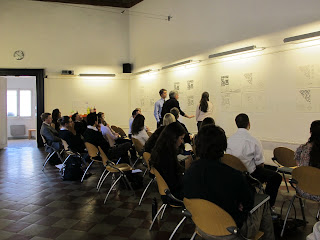In the last weeks of the semester we learned new styles of analyzing architecture while combining methods previously learned in the semester. Along with the closing of studio projects we also visited new sites that we had not seen. We approached our inevitable ending of our semester abroad in Rome and emotions were bittersweet, as much as we all didn't want this time to come to an end. The ending weeks were started off with a day trip to Tivoli to see the famous gardens and Hadrian's Villa.
The Tivoli gardens were not only beautiful and pleasing to the eye but they also were very reminiscent of our past studies of urban fabric because of the planned out pathways that dictate movement around the gardens.
Our next stop was Hadrian's Villa. It was interesting to compare the planned out design of the Tivoli gardens to Hadrian's Villa plans which are now in ruins. Although not much of the villa is left the general forms of the buildings and paths still are present which made it easy for us to imagine what the city would have looked like in its prime.
Upon our return we were tasked two new mini projects that forced us to think outside of the box. We were introduced to collage and ephemeral art, which we found not only interesting but a relaxing process of expressing our analyses. We all enjoyed seeing each other's own approach to these abstract projects.
Another new experience for most of us was going to see a symphony of Beethoven's 7th. It was not only a beautiful performance but we sat inside one of the concert hall's designed by Renzo Piano and were able to have a first hand experience of an architectural wonder.
The most memorable experience of our last week was being surprised by rina and Eric with a two day trip to the island of Capri. Thanks to Dave Shove-Brown we were able to visit the exclusive villa Malaparte. It was a long journey through the hills of Capri but we were rewarded with an amazing building and beautiful view of the island and ocean.
To close off our four month long journey in Italy we had an open house to exhibit all of our work throughout the semester. The open house is where everything came together for us and visitor to admire all of our hard work.
The final dinner that we had last night was a bittersweet goodbye because of the friendships and connections we have made with each other from this semester. We walked around the streets near the pantheon reminiscing over memorable and funny memories that we had. But our final hugs at the outside of the pantheon is where it sank in that we are all leaving, what better place to say goodbye than at the Pantheon. Ciao Roma!
Claudia Wainer and Chris Weimann



























































